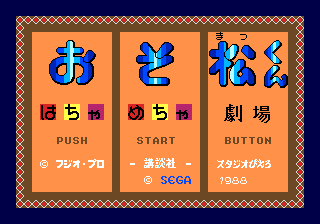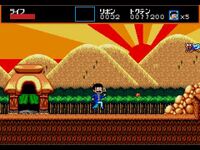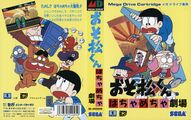Difference between revisions of "Osomatsu-kun Hachamecha Gekijou"
From Sega Retro
m |
m (italics) |
||
| Line 15: | Line 15: | ||
}} | }} | ||
}} | }} | ||
| − | {{stub}}'''''{{PAGENAME}}''''' (おそ松くん はちゃめちゃ劇場) is a [[Sega Mega Drive]] action game developed by [[Sega R&D 2]] and published by [[Sega]]. Based on the Japanese media franchise ''[[wikipedia:Osomatsu-kun|Osomatsu-kun]]'', it was released exclusively in Japan in December 1988, and alongside arcade ports like [[Super Thunder Blade]] and [[Altered Beast]], was the first original game developed for Sega's new 16-bit platform. Notable for its overwhelmingly poor critical reception, the game was universally panned for its short length, maze-like gameplay, frustrating controls, abrasive soundtrack, and frequent crashes, and has gained a cult reputation as one of the worst games on the [[Sega Mega Drive]]. | + | {{stub}}'''''{{PAGENAME}}''''' (おそ松くん はちゃめちゃ劇場) is a [[Sega Mega Drive]] action game developed by [[Sega R&D 2]] and published by [[Sega]]. Based on the Japanese media franchise ''[[wikipedia:Osomatsu-kun|Osomatsu-kun]]'', it was released exclusively in Japan in December 1988, and alongside arcade ports like ''[[Super Thunder Blade]]'' and ''[[Altered Beast]]'', was the first original game developed for Sega's new 16-bit platform. Notable for its overwhelmingly poor critical reception, the game was universally panned for its short length, maze-like gameplay, frustrating controls, abrasive soundtrack, and frequent crashes, and has gained a cult reputation as one of the worst games on the [[Sega Mega Drive]]. |
As ''Osomatsu-kun'' predates the development of the [[TradeMark Security System]], it will only function properly with Japanese or Asian [[Mega Drive]] consoles, or model 1 Mega Drive consoles which lack TMSS (revisions VA0 through VA5.) | As ''Osomatsu-kun'' predates the development of the [[TradeMark Security System]], it will only function properly with Japanese or Asian [[Mega Drive]] consoles, or model 1 Mega Drive consoles which lack TMSS (revisions VA0 through VA5.) | ||
| Line 87: | Line 87: | ||
==External links== | ==External links== | ||
| − | *''[https://mdshock.com/2018/09/16/osomatsu-kun-the-bizarre-story-of-the-mega-drives-most-infamous-game/ Osomatsu-kun: The Bizarre Story of the Mega Drive’s Most Infamous Game]'' article by Gryson at [https://mdshock.com Mega Drive Shock] | + | *''[https://mdshock.com/2018/09/16/osomatsu-kun-the-bizarre-story-of-the-mega-drives-most-infamous-game/ Osomatsu-kun: The Bizarre Story of the Mega Drive’s Most Infamous Game]'' article by Gryson at ''[https://mdshock.com Mega Drive Shock]'' |
==References== | ==References== | ||
Revision as of 09:11, 31 October 2021
| Osomatsu-kun Hachamecha Gekijou | ||||||||||
|---|---|---|---|---|---|---|---|---|---|---|
| System(s): Sega Mega Drive | ||||||||||
| Publisher: Sega | ||||||||||
| Developer: Sega R&D 2 | ||||||||||
| Licensor: Fujio Pro, Kodansha, Studio Pierrot | ||||||||||
| Genre: Action[1][2] | ||||||||||
| Number of players: 1 | ||||||||||
|
This short article is in need of work. You can help Sega Retro by adding to it.
Osomatsu-kun Hachamecha Gekijou (おそ松くん はちゃめちゃ劇場) is a Sega Mega Drive action game developed by Sega R&D 2 and published by Sega. Based on the Japanese media franchise Osomatsu-kun, it was released exclusively in Japan in December 1988, and alongside arcade ports like Super Thunder Blade and Altered Beast, was the first original game developed for Sega's new 16-bit platform. Notable for its overwhelmingly poor critical reception, the game was universally panned for its short length, maze-like gameplay, frustrating controls, abrasive soundtrack, and frequent crashes, and has gained a cult reputation as one of the worst games on the Sega Mega Drive.
As Osomatsu-kun predates the development of the TradeMark Security System, it will only function properly with Japanese or Asian Mega Drive consoles, or model 1 Mega Drive consoles which lack TMSS (revisions VA0 through VA5.)
Contents
Story
Osomatsu-kun's five brothers Karamatsu, Choromatsu, Ichimatsu, Jyushimatsu, and Todomatsu have been kidnapped by villains Iyami and Chibita. Armed with only his slingshot, Osomatsu-kun sets out to rescue his brothers.
Gameplay
The game plays as an action platformer with frequent maze elements, featuring controls that have been unanimously described as "floaty". Osomatsu-kun can jump with ![]() , fire projectiles from his slingshot with
, fire projectiles from his slingshot with ![]() , and has access to various items acquired throughout the game by pressing START .
, and has access to various items acquired throughout the game by pressing START .
Stages
Each of the game's three stages is further divided into four segments: the main area, sky area, water area, and underground area.
Development
Osomatsu-kun Hachamecha Gekijou was originally developed for a 4MB cartridge, but due to chip shortages being experienced by Japan, the game was notably reduced to a 2MB cartridge. To accommodate this, Sega R&D 2 removed the second half of the game entirely, from the levels to the end-game credits.[3]
Fujio Akatsuka, author of the original manga, was outspokenly critical about video games and considered them to be a problem plaguing Japanese youth. After the release of Osomatsu-kun Hachamecha Gekijou, the author was so offended by its poor quality that during a meeting with Sega R&D 2, Akatsuka became enraged and threw an ashtray at one of the developers. Confirmed by multiple employees of both Sega and SIMS (which many Osomatsu-kun staff later migrated to), the story of Akatsuka's thrown ashtray spread to other employees within the company, and eventually to the gaming public.[3]
Quotes
| “ | Sega was thinking about what titles to release with its new 16-bit platform. They ended up losing Tetris, and the titles they did release were just no good. Altered Beast and Osomatsu-kun… the quality of that one was really “shoddy.” They were worthless titles. For Altered Beast, I wanted to use the same large amount of memory as the System 16 arcade version. In that case, it would have been much better. However, when you significantly reduce the memory, the end result is not good. This happened with three or four titles.
At the time, we held this huge promotional event. We had Seikō Itō [a Japanese celebrity] there. We announced that the 16-bit era had arrived, and we showed off several games. Everybody there was dumbfounded at how bad the games were. When I saw this, I thought that I had made a huge mistake in the design of the Mega Drive’s architecture. I thought that the hardware was only capable of putting out games like that. A bit later, I saw the shooting game Thunder Force II, which made great use of the specific functions of the 16-bit platform, such as line scrolling. And this was from a third party developer. When I saw that game, I finally felt relieved that I hadn’t been so wrong in the design of the architecture. Up to that point, the titles Sega had put out were worthless. |
„ |
— Sega R&D Head and Mega Drive designer Hideki Sato[3] | ||
Reception
Universally panned upon release, the game has gained a cult following as a classic kusoge (shit game), and was frequently voted one of the absolute worst Sega Mega Drive games by readers of Beep! MegaDrive magazine.[3]
Magazine articles
- Main article: Osomatsu-kun Hachamecha Gekijou/Magazine articles.
Promotional material
Physical scans
| Sega Retro Average | ||||||||||||||||||||||||||||||||||
|---|---|---|---|---|---|---|---|---|---|---|---|---|---|---|---|---|---|---|---|---|---|---|---|---|---|---|---|---|---|---|---|---|---|---|
|
| 53 | |
|---|---|
| Based on 6 reviews | |
Technical information
ROM dump status
| System | Hash | Size | Build Date | Source | Comments | |||||||||
|---|---|---|---|---|---|---|---|---|---|---|---|---|---|---|
| ✔ |
|
256kB | 1988 | Cartridge (JP) |
External links
- Osomatsu-kun: The Bizarre Story of the Mega Drive’s Most Infamous Game article by Gryson at Mega Drive Shock
References
- ↑ File:OsomatsuKun MD JP Box.jpg
- ↑ 2.0 2.1 https://sega.jp/history/hard/megadrive/software.html (Wayback Machine: 2020-07-20 09:51)
- ↑ 3.0 3.1 3.2 3.3 https://mdshock.com/2018/09/16/osomatsu-kun-the-bizarre-story-of-the-mega-drives-most-infamous-game/ (Wayback Machine: 2018-09-17 16:43)
- ↑ Aktueller Software Markt, "Oktober 1989" (DE; 1989-08-28), page 66
- ↑ Beep! MegaDrive, "February 1990" (JP; 1990-01-08), page 71
- ↑ Beep! MegaDrive, "February 1990" (JP; 1990-01-08), page 1
- ↑ Joystick, "Juillet/Août 1990" (FR; 1990-06-25), page 111
- ↑ Mega Drive Fan, "November 1989" (JP; 1989-10-07), page 49
- ↑ Sega Saturn Magazine, "September 1995" (JP; 1995-08-08), page 87
| Osomatsu-kun Hachamecha Gekijou | |
|---|---|
|
Main page | Maps | Hidden content | Bugs | Magazine articles | Reception | Region coding | Technical information | |






